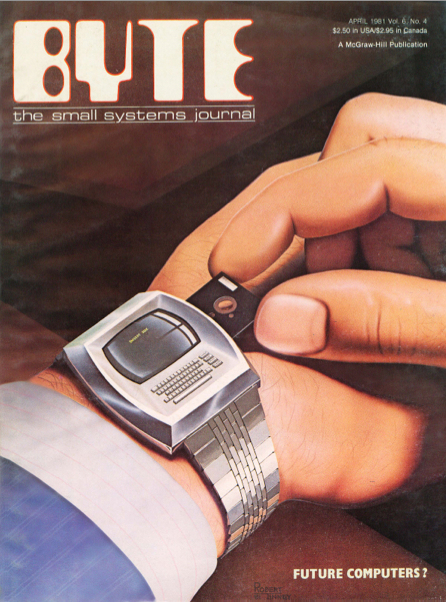[2023]
[2022]
[2021]
[2020]
[2019]
[2018]
[2017]
[2016]
[2015]
[2014]
December
November
October
September
August
July
June
May
April
March
February
January
[2013]
[2012]
[2011]
[2010]
[2009]
[2008]
[2007]
[2006]
[2005]
[2004]
[2003]
[Tue Apr 15 19:33:50 CDT 2014]
A friend posted on Facebook today a link to a story from Time about a magazine cover that, according to them, explains why we are so bad at tech predictions. The cover does look quite naive, indeed:
However, funny as it looks, the article itself explains how it was published in the April 1981 issue of Byte (in other words, it was meant to be as an April Fools' Day joke. Said that, it still doesn't change the fact that, as the author of the aricle explains apropos the concept of smartwatch, which is quickly becoming a fade of sorts:

Yep. I think I've already written about it elsewhere, but I just cannot see how the current batch of smartwatches (and other wearable devices too, including the much touted Google Glass) can become popular enough among the regular people out there. They just don't have much to offer. They simply do the same as smartphones but, of course, are far more annoying and cumbersome to use. Why should anyone bother? Well, at least anyone who doesn't belong in the group of gadget lovers, that small group of techno-fetishists, also known as "early adopters", who will always buy the latest and greatest gadget, whether it makes sense or not. Yet, none of this is to say that, if the manufacturers are able to come up with something different, they may not become the new consumer hit. However, for that to happen they will have to offer a clear value add, which is not the case so far. I simply cannot see how I can justify spending hundreds of dollars (or over US $1,000 in the case of the Google Glass) on one of these devices. {link to this entry}First, it reminds us that the smartwatch is not a new idea. Even in 1981, tech companies had been trying to build them for a while: Tinney's creation is a pseudo-logical extension of ideas expressed in real devices such as HP's HP-01, a "personal information assistant" intoduced in 1977. (Of course, people have been obsessed with the notion of strapping advanced communications gadgetry to their wrists since at least 1946, when Dick Tracy got his wrist radio.)
Here we are in the 21st century. The tech industry has lately made progress on this smartwatch idea, but it's still not a problem that anyone's completely solved, which is why it still isn't part of everyday life. You could do a "Future Computers" cover today and put a concept smawrtwatch on it, just as Byte did in 1981.
Second, for all the ways technology has radically improved in the past 33 years, the current crop of smartwatches actually have a lot in common with Tinney's concept. The industry is still struggling with questions of display technology, input and storage, and one of the best efforts so far, the Pebble Steel, even looks eerily like the Tinney watch, sans QWERTY.
But most of all, the Tinney watch is a wonderful visual explanation of why human beings —most of us, anyhow— aren't very good at predicting the future of technology. We tend to think that new products will be a lot like the ones we know. We shoehorn existing concepts where they don't belong. Oftentimes, we don't dream big enough.
[Mon Apr 7 12:53:23 CDT 2014]
Here is a question that a few people asked me lately and that, surprisingly, has a very easy and straightforward answer: How do I know what version of Java I'm running? I have no idea how it works in Windows, but in the case of Linux or Mac OS X, open the terminal and enter the following command:
As you can see, I'm running OpenJDK version 1.6.0_27, and it's also a 64-bit release. In the case of 32-bit versions, it simply won't say anything about the architecture. That's all there's to it. {link to this entry}$ java -version java version "1.6.0_27" OpenJDK Runtime Environment (IcedTea6 1.12.6) (6b27-1.12.6-1~deb7u1) OpenJDK 64-Bit Server VM (build 20.0-b12, mixed mode)